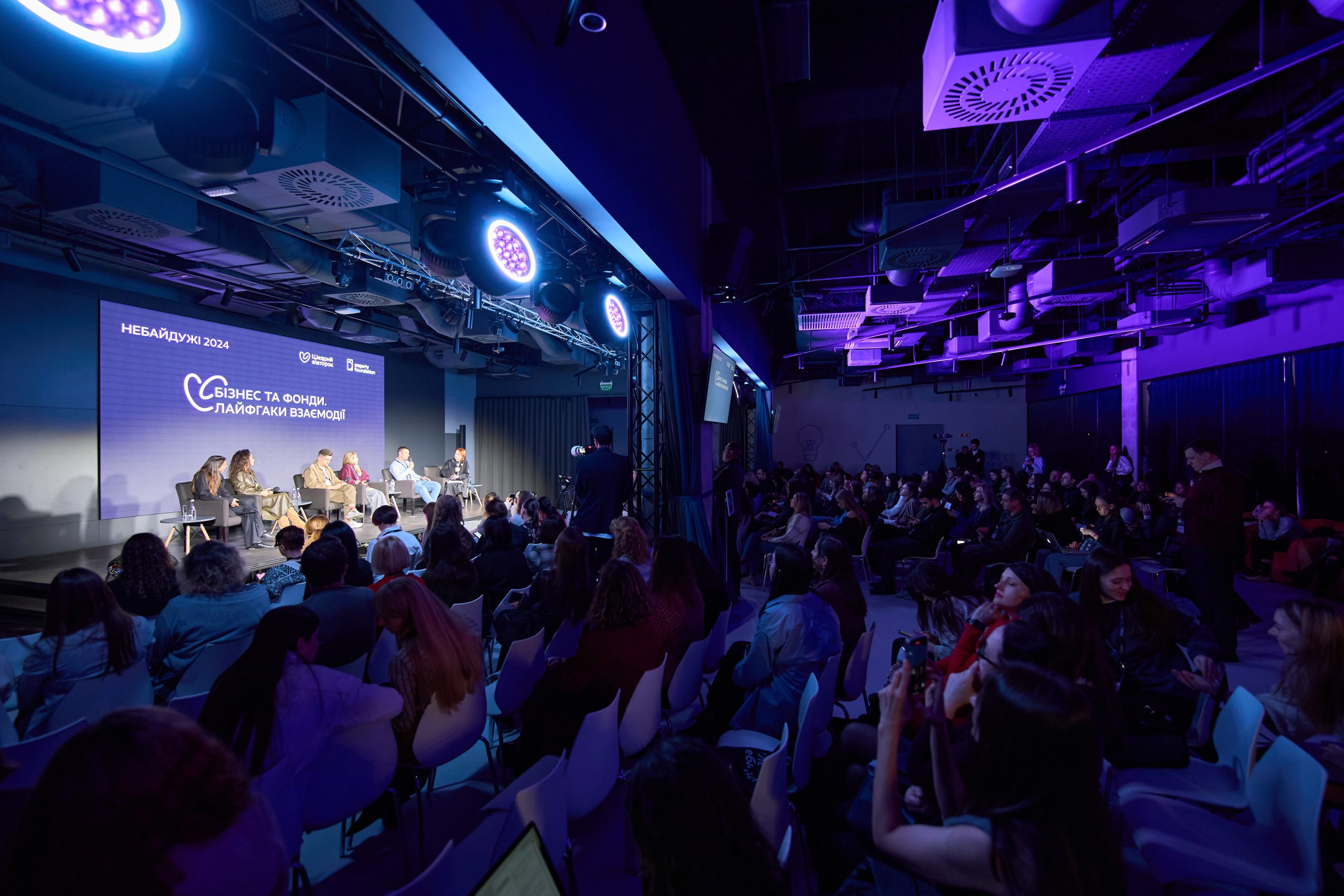Read 10 min,
IRYNA SOLOVEY: ON THE CONSEQUENCES OF BUSINESS INVOLVEMENT IN PUBLIC ACTIVITIES

IRYNA SOLOVEY
Community development strategist, president of the Garage Gang NGO, and co-founder of the Big Idea social innovation platform.
ONE OF THE STEREOTYPES THAT NEED TO
BE overcome, with the war helping to do that, is that business is something autonomous within the body of a society. I’m using this biological metaphor, because it is important to think of society as an ecosystem in which everything is interconnected. And if we accept this view, it will be easier for businesses to develop social responsibility strategies that are linked to their business strategy and are not limited to public relations. Nowadays,
it is easier to spot publicity projects: If a company spends disproportionately more on communication around a project than on its actual benefits, it is not about charity or change. In this case, social appeal is used as a new style of marketing. But is it because this is how international practice is interpreted, or because managers cannot think of any other way to create value than through publicity? I have no clear answer. Obviously, businesses will continue to want to work with reputation, create their own image, and increase their political weight. Still, I suggest distinguishing these actions from those that a company takes as an integral part of the social system.
WHY DO BUSINESSES CREATE THEIR OWN CHARITY PROGRAMS AND PROJECTS? This is
partly due to our generally weak management school. Looking deeper, performance evaluation and developing criteria for working with other organizations are all about data work and culture of data-driven decision making.
Since we are a post-colonial country, our development strategies were for some time developed by others. And until the strategy is developed independently, the value of data is low. Therefore, we have an underdeveloped, almost atrophied analytics sector. (To be fair, it is now starting to emerge due to business needs). And when you lack analytics, you are
forced to speculate on perception, and whoever explains something in the simplest and most accessible way wins in that game. Thus, the business sector has no analytics on its direct activities, while the civil society sector has
no analytics on its influence. Consequently, partnerships are built on personal contacts and ability to persuade. That’s better than nothing, of course. Over the past decade, the non-profit sector, thanks to commercial experts coming there at the call of the heart, has developed a competent approach that the business could rely on to implement social responsibility programs. Prior to this, the goal often compensated for the quality of execution, and management skills were
lacking to ensure a systemic, sustainable, and structural approach and partnership capacity.
It is therefore not surprising that companies now want to create their own projects that work in a way that they understand. They believe there is no system for them to rely on in the civil society sector. Still, it should be invented.
I SUPPOSE THAT BUSINESS INVOLVEMENT IN THE CIVIL SOCIETY SECTOR WILL AFFECT CIVIL SOCIETY DEVELOPMENT, INCREASING CITIZEN AWARENESS. We
should understand that those companies that have implemented some kind of corporate social responsibility programs relating to climate change, gender equality, or anything else provided for by EU legislation, have done so not necessarily because they are sincerely concerned about these issues — they needed to enter the European market. Now, due to the full-scale war, they have tried to do something else that affects life inside the country. Once the existential threat recedes, the challenges for business will not disappear — they will just change. For example, they will relate
to the restructuring of global economy, changes in human capital structure, etc. Businesses will then have to worry about not only external impact and reputation but also internal programs. For instance, charity programs can provide value to employees in companies where their work result is much delayed. This helps to maintain people’s identity and civic competence, so that they feel that they can change and decide on something not only during elections every four years but daily. Another point is that one can influence environment in different ways: through cultural, educational, and volunteer projects. This creates a kind of relationship where a company can attract
a person with more than money, since material rewards no longer work so well.
SUPPORTING EMPLOYEES’ PROJECTS
WITH FUNDS or matching funds from employees and the company for something useful are potentially effective corporate social responsibility practices. For example, a company might give each employee a certain amount of money to invest in a project they consider important and then double that person’s contribution. This matching funds strategy provides flexibility that works for both business strategy and building trust within
the team. It also overcomes the problem of many hermetic programs, where all aid-related decisions are made by top managers, while
the team is not involved. It may also be nice for a business to have dedicated money, e.g., via its own foundation, to support charitable or community projects that people in the team are interested in. Of course, this means that the company has to develop competencies in other, unrelated areas, which is unprofitable for any business. At the same time, there is room for partnerships with the civil society sector — we can’t do without expertise.
IT IS NOW IMPORTANT FOR BUSINESSES TO COMMUNICATE WITH PUBLIC AND CHARITABLE ORGANIZATIONS AND BUILD
PARTNERSHIPS. As a result, a pool of 4–5 permanent joint initiatives can be formed, which is good for both businesses and nonprofits, as they will feel systemic support. Another important aspect is that the team needs to communicate about the outcomes and changes resulting from cooperation.
IN THE CULTURE OF GIVING, GRATITUDE COMPLETES THE CYCLE AND FOSTERS
TRUST AND EQUALITY. At its time, the launch of Big Idea was aimed at developing the culture of giving in Ukraine. Crowdfunding was often perceived as a fundraising tool that creates transactional relationships. Instead, its importance has always been in building peer- to-peer relationships: Someone delegates funds, and someone implements an idea. Let me illustrate this with a simple example. When I go to a coffee shop, pay, and get a cup of coffee, that is a transactional relationship. We have no reciprocity, only monetary relations.
If I say, «What a great coffee you have, you support my productivity,» and the barista says something nice in response, this is a reciprocal exchange. Only now, in 2023–2024, did we reach the point where the culture of giving took root. Now, even those who raise money for the army, something so obvious and necessary, think about what they can give back to their donors. After all, when one gives and the other takes, it is an unequal
relationship that experiences certain pressures and collapses instead of stitching society’s fabric together. Let’s look at the fundraising campaigns of the largest foundations at the beginning of the invasion. At that time, they talked about victory as the key value, which sounded rather abstract. It got soon clear that such fundraisers were difficult to close because they lacked specifics. Now think about current campaigns: They always have information about who they are for, what they are for, and what they can change. What is more, it is no longer, say, «Prytula raised UAH 1,000,000,» but more and more often «We raised UAH 1,000,000 together.» That is, the contribution has begun to be appreciated and gratitude expressed. This creates trust, involvement, and even a psychotherapeutic effect.
CHARITABLE ORGANIZATIONS SHOULD MAKE SURE THAT THEIR DONORS RECEIVE
GRATITUDE. The question is in which way. In charity, it is often assumed that a donor is transferring a resource and must use their mind to understand what will change for the better. As the cycle is incomplete, such a donor feels abandoned and must somehow maintain their motivation on their own. This
is extremely difficult to do over the long run. I once counseled an organization that received UAH 100,000 from its largest donor, which was a lot of money at the time. The team of this organization could not figure out how
to thank that person. A simple «thank you» was not enough — they needed to make a gift. We talked with them about what this donor had done before making his decision. It turned out that he had calculated how much money could have a significant impact on
the organization’s work. So, they prepared a detailed report on what they had been able to change using the money, and this was an appropriate form of gratitude that the donor gladly accepted. Furthermore,
this enabled the organization to engage him again, because he saw how much they had grown operationally using his contribution. Ideally, a nonprofit should find and use the best form of gratitude for its partners.
ANOTHER CONSEQUENCE OF THE CHALLENGES OF WAR MAY BE A CHANGE IN THE BUSINESS-STATE RELATIONSHIPS.
Their shared experience can lead to the social responsibility or charity of a company no longer signaling of the need to check its taxes. Business in Ukraine was formed in the conditions of a newly opened market, rapid
growth that exhausted our human capital, and then the effects of war. Now, we are facing a shortage of qualified specialists — physically. Why is this happening now? Let’s go back to the competency of managers: They look at cash gaps rather than analytics. Therefore, the business and the state will likely have to work together methodically in the field of education, without expecting swift results, because transparent conditions have not yet
been created. This can change, though, for the business is interested in competent employees able to create innovations, while the state is interested in these innovations and in keeping people in Ukraine with its economy growing. I do not think that our challenges will ever allow the state and the business to separate and do their own thing. On the contrary, a space for interaction and cooperation will emerge — we can already see this in communities. So, we all need each other as parts of a single organism.






